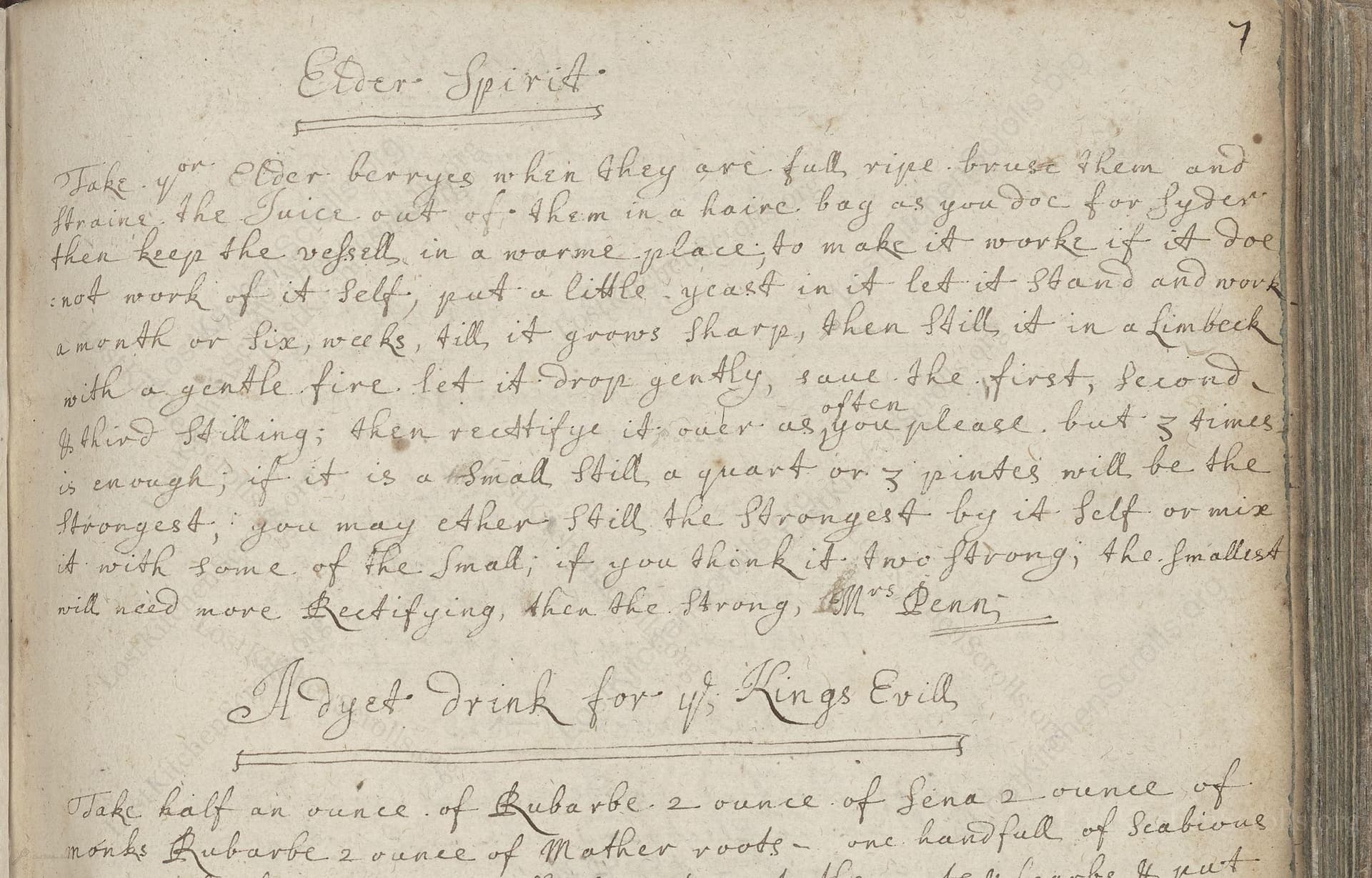Elder Spirit
From the treasured pages of Cookbook of Jane Dawson
Written by Jane Dawson

Elder Spirit
"Take. yo Elder berryes when they are full. ripe. bruse them and ftraine. the Juice out. of. them in a haire bag as you doe for Syder. then keep the vefsell. in a warme place; to make it worke if it doe not work of it Self. put. a little. yeast in it let it Stand and worke a month or Six, weeks, till, it grows Sharp, then Still it in a Limbeck with a gentle fire. Let it Drop gently, save the first, second. & third Stilling; then rectiffy it. over as you please. 3 times is enough; if it is a Small Still a quart or 3 pintes will be the Strongest; you may ether Still the Strongest by it. Self or mix it with Some. of the Small. if you think it two Strong; the Smallest will need more. Rectiffying, then the. Strongest. Mrs. Denn;"
Note on the Original Text
Seventeenth-century recipes often read as kitchen notes—the instructions are continuous, sprinkled with capitalized nouns, erratic punctuation, and minimal measurements. Words like 'yo' for 'your,' and spellings like 'ftraine' for 'strain,' reflect period orthography and regional dialects. Earlier manuscripts rarely specify quantities, leaving much to the cook's judgement, and rely heavily on experiential knowledge. The term 'worke' referred to fermentation (bubbling), and 'month or Six weeks' gave leeway based on environmental conditions. The repeated distillation—a hallmark of medicinal and potable spirits—ensured a purer and more potent product, suitable for both feasting and physic.

Title
Cookbook of Jane Dawson (1690)
You can also click the book image above to peruse the original tome
Writer
Jane Dawson
Era
1690
Publisher
Unknown
Background
A delightful glimpse into late 17th-century English kitchens, Jane Dawson's recipe collection is a flavorful tapestry of sweet delicacies and savory dishes, revealing the tastes and ingenuity of bygone home cooks.
Kindly made available by
Folger Shakespeare Library
This late 17th-century recipe comes from Jane Dawson, an Englishwoman whose household manuscript captures recipes both medicinal and convivial from post-Restoration England. The making of a distilled elderberry spirit would have been typical for well-resourced English homes, where experimentation with fruit and herbal infusions was common, both for medicinal cordials and strong drink. Elderberries were highly valued for their medicinal properties and vivid flavor—often associated with rural domesticity and female knowledge in the kitchen. Distillation was a sophisticated method reserved for those with access to specialized equipment and the leisure to tend months-long fermentations.

Historically, this recipe required a 'hair bag' for straining fruit pulp—a fine sieve made from animal hair—followed by fermentation crocks or barrels, kept near the hearth or in a warm pantry. For distillation, a 'limbeck' was used—a traditional copper alembic still, heated gently over a coal or wood fire. The spirit was collected in glass or stoneware vessels, and repeated distillation ('rectifying') required patience, close attention to separations, and careful storage.
Prep Time
30 mins
Cook Time
3 hrs
Servings
10
We've done our best to adapt this historical recipe for modern kitchens, but some details may still need refinement. We warmly welcome feedback from fellow cooks and culinary historians — your insights support the entire community!
Ingredients
- 4.4 lb ripe elderberries (Sambucus nigra)*
- Optional: 0.18 oz wine yeast or baking yeast (as substitute for historical yeast)
- Sterile water (as needed to adjust for juicing efficiency)
- Note: If elderberries are unavailable, blackcurrants can be a substitute, though the character will differ
Instructions
- To create Elder Spirit in a modern kitchen, begin by harvesting about 4.4 pounds of fully ripe elderberries (ensure they are Sambucus nigra and not the poisonous red varieties).
- Gently crush the berries and strain their juice through a fine mesh (a nut milk bag or fine sieve works well), much as you would extract juice for cider.
- Place the juice in a sterilized fermentation vessel and keep it in a warm place (about 68-75°F).
- If the juice does not ferment on its own within 24 hours, add about 0.18 ounces of baking yeast or, preferably, wine yeast.
- Allow the mixture to ferment for 4-6 weeks, checking periodically; when it has turned sharp-tasting (like dry wine or strong cider), distill the liquid using a small still over gentle heat.
- Collect the resulting spirit in three separate fractions.
- The first and second runs are the strongest.
- Redistill (rectify) the spirit up to three times for purity.
- You may blend the strongest portions with weaker ones if the raw spirit proves too potent.
- Additional distillations will further refine the weaker distillates.
Estimated Calories
70 per serving
Cooking Estimates
You will need about 30 minutes to prepare the elderberries and start fermentation. The fermentation takes about 4-6 weeks, but most of the time is hands-off. Distillation and collection can take about 3 hours. This recipe yields about 500 ml of spirit, typically divided into 10 servings, and each serving has around 70 calories.
As noted above, we have made our best effort to translate and adapt this historical recipe for modern kitchens, taking into account ingredients nowadays, cooking techniques, measurements, and so on. However, historical recipes often contain assumptions that require interpretation.
We'd love for anyone to help improve these adaptations. Community contributions are highly welcome. If you have suggestions, corrections, or cooking tips based on your experience with this recipe, please share them below.
Join the Discussion
Rate This Recipe
Dietary Preference
Main Ingredients
Culinary Technique

Den Bockfisch In Einer Fleisch Suppen Zu Kochen
This recipe hails from a German manuscript cookbook compiled in 1696, a time whe...

Die Grieß Nudlen Zumachen
This recipe comes from a rather mysterious manuscript cookbook, penned anonymous...

Ein Boudain
This recipe comes from an anonymous German-language manuscript cookbook from 169...

Ein Gesaltzen Citroni
This recipe, dating from 1696, comes from an extensive anonymous German cookbook...
Browse our complete collection of time-honored recipes



